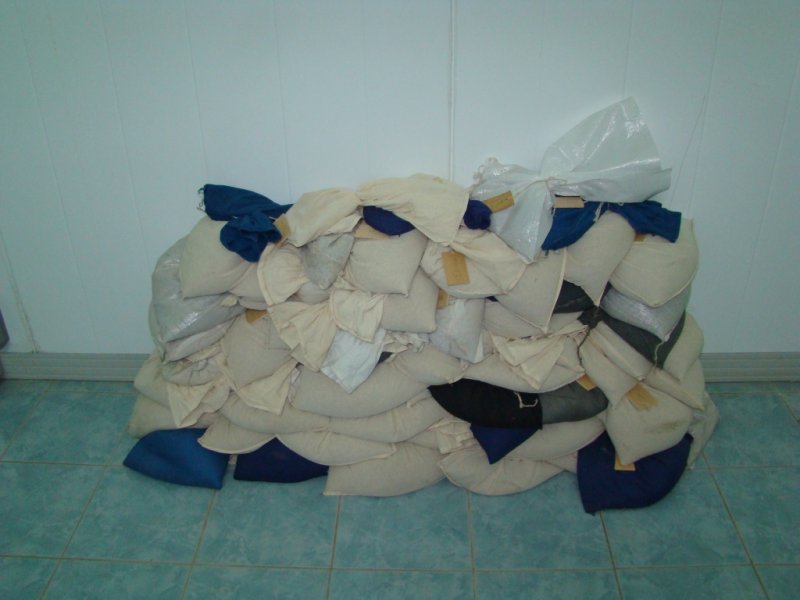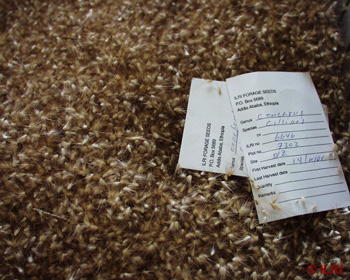Sample processing of forage grass genetic resources
Contributors to this page: ILRI, Addis Ababa, Ethiopia (Jean Hanson); Bioversity International/ILRI, Addis Ababa, Ethiopia (Alexandra Jorge).
|
Contents: |
This is the removal of physical contaminants from plant material after harvesting, before storage. Although awns can be removed, it is not recommended to remove glumes because this can damage the delicate caryopses.
- Machine threshing is usually followed by air screen cleaning because grass seeds are light and easily separated by blowing. All contaminants should be removed because of space constraints and cost of storage.
When using mechanical threshers, carefully clean with a brush or air blower between lots to:
- Avoid contamination with seeds of accessions previously threshed.
- Prevent diseases and pests from being passed from one accession to another.
The final cleaning should be done by hand cleaning.
Visual inspection of seeds
Visual inspection is essential in genebanks to reach high standards of removing debris, including empty or infected seeds, needed for long-term storage. This is also important to check and prevent the further spread of insect and fungal damage. Insecticides can kill adult insects but may not kill insect larva, eggs and fungi.
According to the International Seed Testing Association rules, the following steps should be followed:
- Spread the seeds on a flat well lit surface of contrasting colour.
- An illuminated table can be used if available.
- Examine dry seeds with the naked eye or under a binocular microscope (this method reveals free moving insects, larva and eggs, mites, fungal fructifications, bacterial masses, infected plant debris).
- Examinations under or near ultraviolet reveals infections of certain fungi and bacteria through emission of fluorescence.
For insect and fungal damage
- Isolate the infested/infected samples.
- Destroy samples when quarantine diseases and/or insects are observed.
- Otherwise clean the seeds before storage using fumigation to control insects.
For mechanical damage and empty seeds
- Some species of grasses are prone to empty seeds, where there is no caryopsis in the glumes. These can appear as seeds with a simple inspection and a light table or x-ray equipment may be needed to identify full seeds. Shriveled, empty and damaged seeds should be manually removed before storage.
Special treatments

Seeds collected from the fields, after receiving the cold treatment to eliminate any insects (Belarus genebank) |
- If infested with insects, place seeds in a deep freezer for three days.
- There is no information on the effects of agrochemicals on longevity during storage in genebanks, so it is better to avoid them. This is also better for staff health and safety.
- Fumigate with agrochemicals when the previous option is not possible.
Disposal of contaminated material
- Incinerate or autoclave contaminated materials, to avoid spreading diseases and pests, and destroy infected material by burning.
Inspection and certification (purity analysis of seeds)
- This should be done according to International Seed Testing Association rules, following their standard methods (see purity analysis).
Recording information during seed cleaning
The following information should be recorded for each processing step:
- Accession number (an ID number).
- Lot number (an ID number).
- Seed weight (weight of seeds for storage).
- Reference to seed source (to trace the origin of the sample).
- Flags (Y/N) indicating completion of steps mentioned above (checking).
- Remarks.
Method recommended in genebank standards
- Use a dehumidified drying room with 13-15% relative humidity and 20-25oC.
- A relative humidity of 13-15% is however sometimes very hard to achieve. A relative humidity up to 25-30% can also be used, but it will prolong the drying period.
- The seed samples should be kept in paper, mesh or cotton bags on mesh racks during the drying period.
Drying time:
- Depending on seed size, from 2-8 weeks.
- The lower the relative humidity the faster the seeds will dry.
Moisture content before drying:
- Depending on seed size and seed coat, 8-12%.
- Up to 20% for Lupinus spp.
Moisture content for storage:
This is recommended in genebank standards (FAO/IPGRI, 1994) and experience shows that seeds remain with high viability for >20 years, when using this standard.
- In general should be around 5% +/- 2%.
- Except for soybean that should be not less than 8%.
Critical moisture content:
The critical moisture content is the level below which further reduction in moisture content no longer increases seed longevity in low temperature storage. Critical moisture content values vary with storage temperature and species. For more information see Rao et al, (2006).
- It is recommended for most of the crops not to dry below 3% to avoid any adverse effects on the seed texture and viability. However, recent findings suggest drying to 2% to extend the storage period.
- This has not yet been researched for many forage grasses.
Recording information during seed drying
The following information should be recorded for each processing step:
- Accession number (an ID number).
- Lot number (an ID number).
- Seed weight (weight of seeds for storage).
- Reference to seed source (to trace the origin of the sample).
- Flags (Y/N) indicating completion of steps mentioned above (checking).
- Remarks.
Determination of seed moisture content
Methods
Sampling frequency:
Standard drying periods under the drying conditions available in the genebank have been determined and so it is only necessary to measure moisture content on sample accessions once.
- Sample once at end of drying period to determine moisture for storage.
- Random sample during storage, in case there are holes in the bags.
Calculate seed moisture content by weight loss on a wet weight basis.
Sample size:
This method follows a modified ISTA 2005 method using more replicates of smaller weight of seeds.
- Take 1.0-2.0 g (0.25-0.5 g for small seeded species) from each sample as two independent replicates.
Pre-drying
Pre-drying is obligatory if seeds are wet and their moisture content is suspected to be above 17%; it should be conducted prior to moisture content determination by oven-drying.
If pre-drying is required, proceed as follows:
- Weigh two sub-samples of 4-5 g of seeds in their containers.
- Pre-dry the samples overnight in a warm, dry place such as a laboratory bench.
- Weigh them again in their containers and determine the loss of weight (loss of moisture) by subtraction.
- Calculate the moisture content on a fresh-weight basis.
Grinding:
Grinding is recommended for large seeded species such as forage oats (about 2-3 mm) to ensure small particles for efficient removal of moisture.
- Coarse grinding the sample using an adjustable mechanical grinder.
Grass/cereal species for which grinding is obligatory (ISTA, 2008):
Avena spp.
Hordeum vulgare
Secale cereale
Sorghum spp.
Triticum spp.
Zea mays
Oven drying temperature:
This is another standard and proven method, and the best practice is to follow the ISTA (2008) suggested methods.
Recording information during determination of seed moisture content

Buffel grass seed (photo: ILRI) |
The following information must be recorded for each processing step:
- Accession number (an ID number).
- Lot number (ID number).
- Taxonomic identification.
- Date of test (the date that the test was commenced).
- Method (name of standard method).
- Drying temperature (oven temperature).
- Fresh weight in grams (weight of sample per replication).
- Dry weight in grams (weight of sample per replication).
- Moisture content (percentage moisture content after drying).
References and further reading
FAO/IPGRI. 1994. Genebank standards. Food and Agriculture Organization of the United Nations, Rome and International Plant Genetic Resources Institute, Rome. Available in English, Spanish, French and Arabic.
ISTA. 2008. International Rules for Seed Testing. International Seed Testing Association. ISTA secretariat, CH-Switzerland. Available from: www.seedtest.org/.
Loch DS, Harding WAT, Harvey GL. 1988. Cone threshing of chaffy grass seeds to improve handling characteristics. Queensland Journal of Agricultural and Animal Sciences 45:205-212.
Rao NK, Hanson J, Dulloo ME, Ghosh K, Nowel D, Larinde M. 2006. Manual of seed handling in genebanks. Handbooks for Genebanks No. 8. Bioversity International, Rome, Italy. Available in English (1.5 MB), Spanish (1.4 MB) and French (1.9 MB).
Comments
- No comments found





Leave your comments
Post comment as a guest